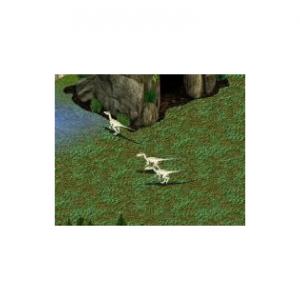About This File
The ivory velociraptor is a leucistic version of the velociraptor. While leucistic animals are light-colored, often white, they are not albinos. Albinism is defined as a defect in the production of the pigment melanin. Albino mammals usually have white fur because they only use melanin as a pigment. Other animals such as reptiles and amphibians have additional sources of pigmentation such as carotenoids (reds, oranges, yellows) and structures that reflect light (iridophores), producing greens and blues; thus, albino reptiles are often brightly colored with reds and yellows.
In extant reptiles and amphibians, there is an absence of cells that produce both melanin and carotenoids, and only a few iridophores are present. The result is white skin. Unlike albinism, color cannot be restored by the transplantation of normal chromoblastic cells and thus seems to be related to a defect in the skin itself. This condition appears to be limited to the skin because leucistic animals often have pigmented eyes, although the irises may be blue instead of the normal brown or black.
It is very likely that leucistic individuals occurred among dinosaurs, just as they do among modern animals; however, such individuals would have a major disadvantage compared to their normally colored fellows because they would stand out and be more likely to fall to predators. Just like leucistic animals today, the ivory velociraptor would have a higher survival rate in captivity than in the wild.
References:
Designer Reptiles and Amphibians. R.D. Bartlett and Patricia Bartlett, 2001.
Reptile and Amphibian Variants: Colors, Patterns, and Scales. H. Bernard Bechtel, 1995.
The Corn Snake Manual. Bill Love and Kathy Love, 2000.
Sites of Interest:
http://www.caudata.org/axolotl/genetics.htm
http://jeb.biologists.org/cgi/content/full/204/12/12/e
http://www.vmsherp.com/LCChromatophores.htm
http://www.herpbooks.com/care2/phen.html
http://www.cornsnakemorphs.com/genetics.html
Created by Ghirin 2003



Recommended Comments
There are no comments to display.
Create an account or sign in to comment
You need to be a member in order to leave a comment
Create an account
Sign up for a new account in our community. It's easy!
Register a new accountSign in
Already have an account? Sign in here.
Sign In Now